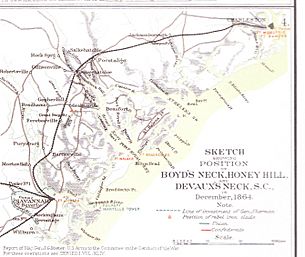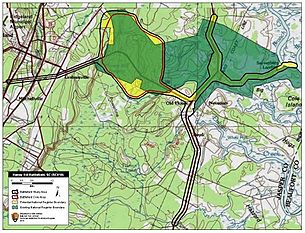Battle of Honey Hill facts for kids
Quick facts for kids Battle of Honey Hill |
|||||||
|---|---|---|---|---|---|---|---|
| Part of the American Civil War | |||||||
|
|||||||
| Belligerents | |||||||
| Commanders and leaders | |||||||
| John P. Hatch | G. W. Smith Charles J. Colcock |
||||||
| Units involved | |||||||
| Coastal Division, Department of the South South Atlantic Blockading Squadron |
Georgia Militia Department of Georgia |
||||||
| Strength | |||||||
| 5,000 | 1,400 | ||||||
| Casualties and losses | |||||||
| 755 total 88 killed, 623 wounded 44 captured |
50 total 8 killed 42 wounded |
||||||
The Battle of Honey Hill was the third battle of Sherman's March to the Sea, fought November 30, 1864, during the American Civil War. It did not involve Major General William T. Sherman's main force, marching from Atlanta to Savannah, Georgia, but was a failed Union Army expedition under Brig. Gen. John P. Hatch that attempted to cut off the Charleston and Savannah Railroad in support of Sherman's projected arrival in Savannah.
Engagement
Hatch's expeditionary force left Hilton Head, South Carolina, for Boyd’s Neck (above Beaufort) on November 28. It consisted of 5,000 men—two brigades of the Coast Division of the Department of the South, one naval brigade, and portions of three batteries of light artillery. They steamed up the Broad River in transports to cut the Charleston and Savannah Railroad near Pocotaligo. Due to a heavy fog the troops were not disembarked from the transports until late the following afternoon, and Hatch immediately started forward to cut the railroad near Grahamville.
However, the expedition maps and guides proved worthless and Hatch was unable to proceed on the right road until the morning of November 30. At Honey Hill, a few miles from Grahamville, he encountered a Confederate force of regulars and militia, under Col. Charles J. Colcock, with a battery of seven guns across the road. Determined attacks were launched by U.S. Colored Troops including a brigade led by Alfred S. Hartwell that included the 54th Massachusetts and 55th Massachusetts. The position of the Federal force was such that only one section of artillery could be used at a time, and the Confederates were too well entrenched to be dislodged. Fighting kept up until dark when Hatch, realizing the impossibility of successfully attacking or turning the flank of the enemy, withdrew to his transports at Boyd’s Neck, having lost 89 men killed, 629 wounded, and 28 missing. The Confederate casualties amounted to eight killed and 39 wounded.
Captains George E. Gouraud and Thomas F. Ellsworth as well as First Lt. Orson W. Bennett were awarded the Medal of Honor. In 2001 another medal was awarded posthumously to then Corporal Andrew J. Smith.
Union order of battle
| Brigade | Regiment and Batteries |
|---|---|
| 1st Brigade |
|
| 2nd Brigade
Col Alfred S. Hartwell |
|
| Naval Brigade
Commander George H. Preble |
|
| Artillery Brigade
Ltc William Ames |
|
| Cavalry
Cpt George Hurlbut |
|
Confederate order of battle
MG Gustavus W. Smith
Col Charles J. Colcock
Chief of Artillery: Col Ambrosio José Gonzales
| Brigade | Regiment and Batteries |
|---|---|
| Provisional Army of the Confederate States |
|
| Reinforcement during battle: BG Beverly H. Robertson |
|
| 1st Brigade, Georgia Militia Col James Willis |
|
| Brigade, Georgia State Line Ltc James Wilson |
|
| Georgia Reserves |
|
Casualties
In a report of Hatch December 1864 summarized the Union losses:
- 1st Brigade: casualties of 2 officers and 54 men killed;28 officers and 409 men wounded; 1 officer and 14 men missing.
- 2nd Brigade: casualties of 3 officers and 28 men killed;10 officers and 160 men wounded; 1 officer and 8 men missing.
- Naval Brigade: casualties of 1 man killed; 7 men wounded; 4 men missing
- Artillery Brigade: casualties of 1 officer killed; 2 officers and 12 men wounded
- Cavalry: casualties of 1 man wounded
The Confederate losses were reported by Lt Col C.C. Jones in his Siege of Savannah as 4 killed and 40 wounded. The Savannah Republican newspaper on Dec 1, 1864 reported "between eighty and one hundred killed and wounded"
See also
 In Spanish: Batalla de Honey Hill para niños
In Spanish: Batalla de Honey Hill para niños



